To list babysitting on a resume, write a brief summary that includes your years of experience, the ages of the children you cared for, and whether you provided in-home care or worked in child care centers. Highlight any unique qualifications, such as fluency in another language or a degree in early childhood education.
You can also use alternative job titles like childcare provider, nanny, or caregiver to describe your babysitting experience professionally.
Introduction To Babysitting On Resumes
Babysitting is not just a job for teenagers. It is a valuable experience that can be highlighted on a resume to demonstrate important skills and qualities. Whether you are applying for a job in childcare, education, or any other field, including babysitting on your resume can showcase your responsibility, patience, and ability to handle challenging situations.
The Value Of Babysitting Experience
Babysitting experience is more than just watching children; it involves multitasking, problem-solving, and effective communication. These skills are highly transferable to various professional environments, making babysitting an asset on a resume.
Addressing Common Misconceptions
Misconception 1: Some people believe that babysitting is a trivial job that doesn’t require any real skills. However, in reality, babysitting involves managing the well-being of children, handling emergencies, and creating a safe and nurturing environment.
Misconception 2: Another common misconception is that babysitting is only relevant for individuals pursuing careers in childcare. In fact, the skills acquired through babysitting, such as multitasking, decision-making, and conflict resolution, are valuable in a wide range of professions.
Crafting A Professional Title
When it comes to listing babysitting experience on your resume, crafting a professional title can make a significant impact. The title you choose should accurately represent your role and responsibilities while also aligning with industry standards. Here’s how to choose the right title and contextualize your role effectively.
Choosing Between Babysitter, Nanny, And Caregiver
When describing your babysitting experience on a resume, it’s crucial to select the most appropriate title. Here’s a breakdown of the distinctions between Babysitter, Nanny, and Caregiver:
- Babysitter: Typically involves occasional or part-time childcare responsibilities, often in the evenings or on weekends.
- Nanny: Involves more consistent and long-term childcare duties, usually on a full-time basis and possibly including additional household tasks.
- Caregiver: Encompasses a broader scope of responsibilities, including caregiving for individuals with special needs or elderly individuals.
Contextualizing Your Role
Once you’ve selected the appropriate title, it’s essential to contextualize your role effectively. This involves providing specific details about your responsibilities and achievements, highlighting the skills and experience gained from your babysitting role.
Structuring Your Experience Section
Babysitting is a valuable experience that can demonstrate your responsibility, nurturing skills, and ability to manage and care for children. When listing your babysitting experience on your resume, it’s essential to present it in a clear and effective manner.
Effective Formatting Strategies
When structuring the experience section of your resume, there are several effective formatting strategies you can employ to showcase your babysitting history prominently:
- Use a clear and concise job title: Instead of simply stating “Babysitter,” consider using alternative titles such as “Childcare Provider,” “Nanny,” or “Caregiver” to add a professional touch to your resume.
- Provide a brief summary: Begin with a brief summary that highlights your years of experience, the ages of the children you cared for, and any unique qualifications or skills you possess, such as fluency in another language or a degree in early childhood education.
- Highlight specific responsibilities: Detail the specific responsibilities you undertook while babysitting, such as engaging children with games and activities, assisting with homework, providing transportation, preparing meals, and handling bedtime routines.
- Quantify your achievements: Where possible, quantify your achievements, such as the number of children you cared for simultaneously or the duration of your babysitting tenure with a particular family.
- Emphasize transferable skills: Highlight any transferable skills gained from your babysitting experience, such as multitasking, problem-solving, and effective communication.
By structuring your babysitting experience section with these strategies, you can effectively showcase your childcare capabilities and make a strong impression on potential employers.
Detailing Your Babysitting Responsibilities
When detailing your babysitting responsibilities on your resume, be sure to include a brief summary of your qualifications, mentioning your years of experience, the ages of the children you cared for, and any unique skills or certifications you have. Highlight any relevant details that set you apart, such as fluency in a foreign language or a degree in early childhood education.
Detailing Your Babysitting Responsibilities When it comes to listing babysitting on your resume, it’s important to showcase the responsibilities you had while caring for children. This not only demonstrates your experience but also highlights your skills and abilities as a caregiver. In this section, we’ll discuss how to incorporate your daily duties, highlight specialized care, and showcase your achievements. Incorporating Daily Duties To ensure that your babysitting responsibilities are clearly outlined on your resume, it’s essential to incorporate your daily duties. This could include tasks such as preparing meals, helping with homework, transporting children to and from activities, and putting them to bed. By listing these tasks, you demonstrate your ability to manage multiple responsibilities and provide quality care for children. Highlighting Specialized Care and Achievements In addition to your daily duties, it’s important to highlight any specialized care you provided while babysitting. For example, if you have experience caring for children with special needs, include this on your resume. You can also showcase any achievements, such as successfully potty training a child or teaching them a new skill. These accomplishments demonstrate your dedication to providing exceptional care and can set you apart from other candidates. Here’s an example of how you could list your babysitting responsibilities on your resume: Babysitter (2018-2020) – Cared for two children, aged 4 and 7, in their home – Prepared meals, snacks, and drinks for the children – Assisted with homework and educational activities – Transported children to and from school and extracurricular activities – Organized and supervised playdates with other children – Provided specialized care for a child with autism, including following a specific routine and providing sensory activities – Successfully potty trained the younger child – Taught the older child basic cooking skills By incorporating your daily duties, highlighting specialized care, and showcasing achievements, you can create a strong and effective babysitting resume. Remember to tailor your resume to the specific job you’re applying for and use keywords from the job description to increase your chances of getting hired.Emphasizing Transferable Skills
When listing babysitting on your resume, emphasize transferable skills such as responsibility, multitasking, and problem-solving. Highlight your years of experience, the ages of the children you cared for, and any additional qualifications that set you apart, such as fluency in another language or a degree in early childhood education.
Emphasizing Transferable Skills Babysitting is often viewed as a part-time job for teenagers, but it can actually provide valuable skills that can be transferred to other industries. When listing babysitting on your resume, it is important to highlight these transferable skills to show potential employers that you have relevant experience and can bring value to their organization. Identifying skills gained from babysitting Babysitting requires a range of skills that can be used in other industries. It is important to identify these skills and highlight them on your resume. Some of the skills gained from babysitting include: – Communication skills: Babysitters need to communicate effectively with children, parents, and other caregivers. This requires strong verbal and written communication skills, as well as the ability to listen actively and respond appropriately. – Problem-solving skills: Babysitters need to be able to think on their feet and solve problems quickly and effectively. This includes handling emergencies, resolving conflicts, and finding creative solutions to everyday challenges. – Time management skills: Babysitters need to be able to manage their time effectively to ensure that they are meeting the needs of the children they are caring for. This includes managing schedules, planning activities, and prioritizing tasks. Matching skills to job requirements When listing babysitting on your resume, it is important to match your skills to the requirements of the job you are applying for. This will help you stand out to potential employers and show them that you have the skills they are looking for. Some tips for matching your skills to job requirements include: – Read the job description carefully to identify the skills that are required for the role. – Use keywords from the job description in your resume to show that you have the relevant skills. – Highlight specific examples of how you have used your babysitting skills in other contexts, such as volunteering or internships. By emphasizing your transferable skills gained from babysitting, you can show potential employers that you have the experience and skills they are looking for. This can help you stand out from other candidates and increase your chances of landing your dream job.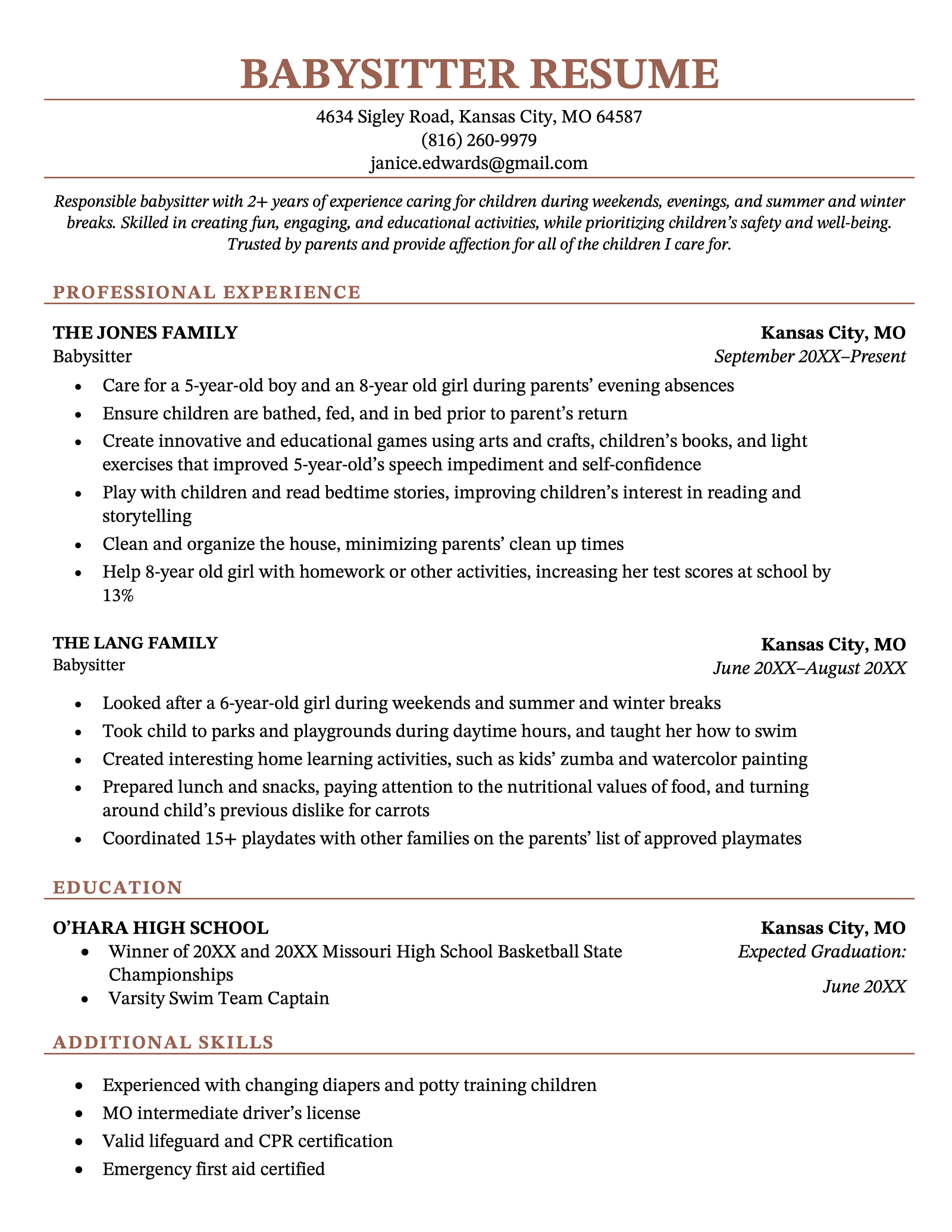
Credit: resumegenius.com
Quantifying Your Babysitting Experience
When listing babysitting experience on your resume, provide a brief summary of your qualifications, including the number of years of experience, the ages of the children you cared for, and whether you worked in a home or child care center environment.
Highlight any unique skills or qualifications, such as fluency in another language or a degree in early childhood education. Consider using alternative job titles such as childcare provider, nanny, or caregiver.
Quantifying Your Babysitting Experience When applying for a job, it’s important to showcase your experience in a way that quantifies your impact and demonstrates your value. Babysitting is no exception, and by quantifying your babysitting experience on your resume, you can show potential employers that you are a responsible and reliable caregiver. Using numbers to demonstrate impact One effective way to quantify your babysitting experience is to use numbers to demonstrate the impact you had on the children you cared for. For example, you could mention how many children you cared for at once, how long you cared for them, or any specific achievements or milestones they reached under your care. Describing scope and variety of care provided In addition to using numbers, it’s also important to describe the scope and variety of care you provided as a babysitter. This could include the ages of the children you cared for, any special needs they had, or any specific tasks or activities you were responsible for. By providing this level of detail, you can show potential employers that you have a diverse range of skills and are capable of handling a variety of situations. Here’s an example of how you could quantify and describe your babysitting experience on your resume: – Cared for up to 4 children at once, ranging in age from 6 months to 10 years old – Provided in-home care, including meal preparation, bathing, and bedtime routines – Facilitated educational activities, such as reading and homework help, resulting in improved grades and academic achievement for all children under my care – Managed challenging behaviors, such as tantrums and sibling conflicts, with positive reinforcement and effective communication strategies – Maintained open and consistent communication with parents to ensure their children’s safety and well-being at all times By following these tips and providing detailed, quantifiable information about your babysitting experience, you can make a strong impression on potential employers and increase your chances of landing the job you want.Including Certifications And Education
When including certifications and education on your resume, it is important to list any relevant qualifications or courses that showcase your skills and knowledge in babysitting. This could include certifications in CPR and First Aid, as well as any coursework or degrees in early childhood education.
Highlighting these qualifications can demonstrate your expertise and dedication to providing safe and nurturing care for children.
Including Certifications and Education When it comes to listing babysitting on your resume, including certifications and education can give you an edge over other candidates. Relevant courses and certifications can show your commitment to childcare and your willingness to learn and improve your skills. Relevant courses and certifications If you have taken any courses or received certifications related to childcare, be sure to include them in your resume. Some examples of relevant courses and certifications include CPR and first aid training, child development courses, and early childhood education certifications. Not only do these show your dedication to the field, but they also demonstrate your ability to handle emergency situations and provide high-quality care to children. Connecting your education to childcare Even if your education is not directly related to childcare, you can still connect it to the skills required for babysitting. For example, if you have a degree in psychology, you can emphasize your knowledge of child behavior and development. If you have experience working as a tutor or mentor, you can highlight your ability to help children with their homework and provide educational support. By connecting your education to childcare, you can demonstrate your transferable skills and show why you are a qualified candidate for the position. In conclusion, including certifications and education can be an effective way to list babysitting on your resume. By highlighting your relevant courses and certifications, as well as connecting your education to childcare, you can showcase your skills and qualifications as a babysitter.Credit: www.jobhero.com
References And Recommendations
When listing babysitting on your resume, include a brief summary of your qualifications, such as years of experience, the ages of the children you’ve cared for, and any unique skills or certifications you have. Use professional terms like childcare provider or nanny to describe your role, and highlight any relevant responsibilities, such as preparing meals, helping with homework, and providing transportation.
When And How To List References
When applying for a babysitting position, it’s essential to include references on your resume. Potential employers value references as they provide insight into your skills and character. Listing references allows employers to verify your qualifications and trustworthiness.
When listing references, ensure to include the individual’s full name, their relationship to you, contact information, and a brief description of your professional relationship. Always seek permission from your references before including their details on your resume.
Gathering Testimonials From Families
When seeking recommendations for your babysitting resume, consider reaching out to the families you’ve worked with. Request testimonials that highlight your strengths and qualities as a babysitter. These testimonials can serve as powerful endorsements of your skills and reliability.
When gathering testimonials, ensure that they are authentic and provide a clear picture of your capabilities. Testimonials should ideally showcase your ability to engage with children, handle responsibilities, and contribute positively to the family’s well-being.
Tailoring Your Resume For Different Roles
When tailoring your resume for different roles, it’s important to know how to list babysitting experience. Instead of using overused phrases, briefly summarize your qualifications including years of experience, ages of children cared for, and any unique skills or certifications.
Use job titles like childcare provider, nanny, or caregiver to describe your role in a professional way.
Adapting The Experience For Diverse Industries
When applying for diverse industries, tailor your babysitting experience to align with the specific requirements. Highlight transferable skills such as communication, time management, and problem-solving that are valuable across various sectors. For example, emphasize leadership and conflict resolution when applying for childcare centers, while focusing on organizational skills and reliability for administrative roles.
Maintaining A Flexible Babysitting Description
Ensure your babysitting description is flexible and can be adapted to suit different positions. Use action verbs like “engaged,” “organized,” and “managed” to showcase your skills effectively. Tailor your description to highlight specific achievements and responsibilities that are relevant to the role you are applying for, allowing hiring managers to see how your experience directly aligns with their needs.
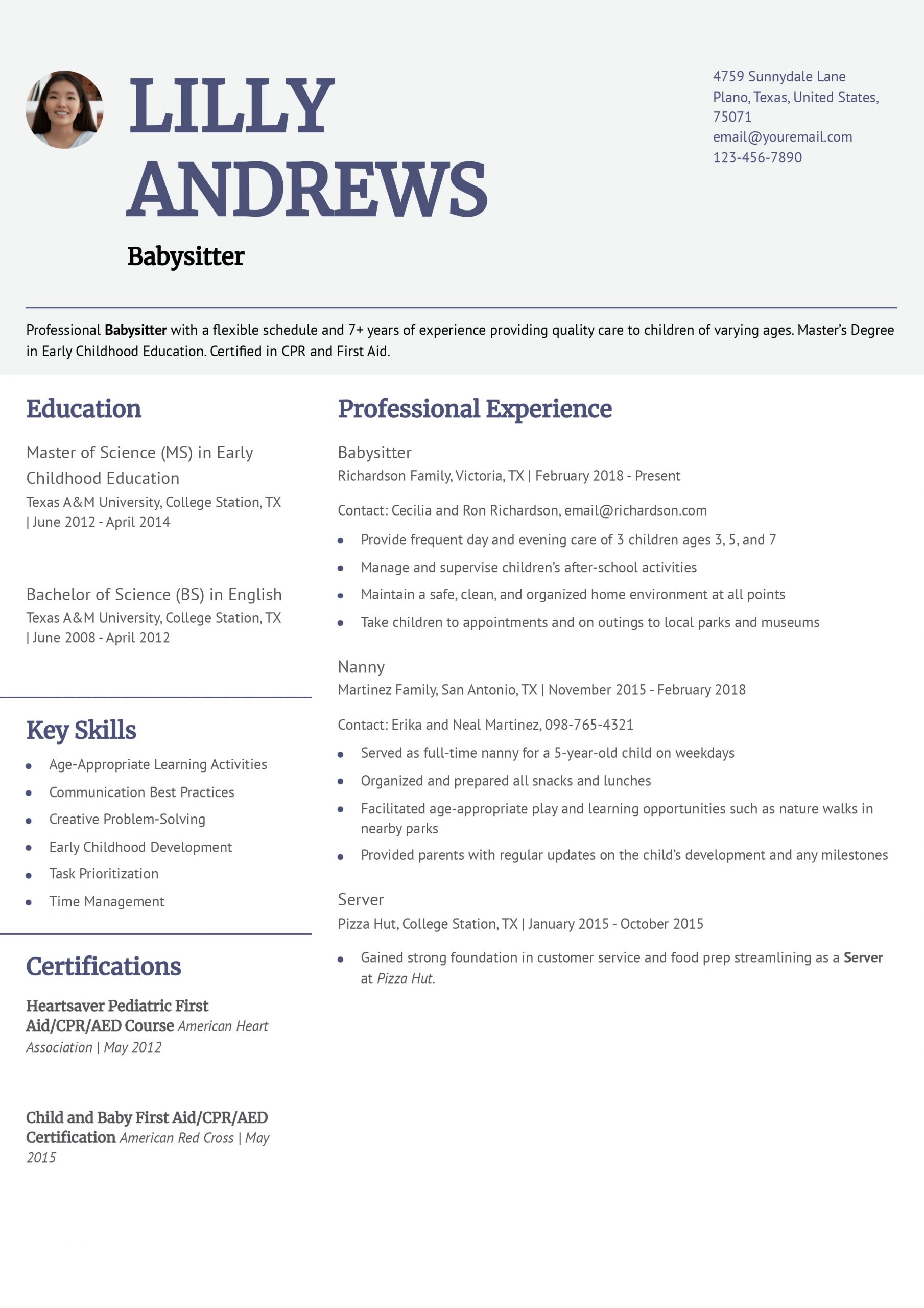
Credit: www.resumebuilder.com
Concluding Your Resume
When concluding your resume, be sure to list babysitting as part of your work experience. Include a brief summary highlighting your years of experience, the ages of the children you cared for, and any unique qualifications such as fluency in another language or a degree in early childhood education.
Remember to use titles like childcare provider, nanny, or caregiver to describe your babysitting experience professionally.
Writing A Compelling Summary
If you want to make a strong impression, writing a compelling summary is crucial. Highlight your experience, skills, and unique qualifications in a concise and engaging manner. Use this section to showcase your passion for childcare and your ability to provide a safe and nurturing environment for children. Focus on your key strengths and what sets you apart from other candidates. Make sure to tailor your summary to the specific job you are applying for, emphasizing the skills and experience that are most relevant.
Final Checklist Before Submission
- Review for any spelling or grammatical errors.
- Ensure the contact information is accurate and up-to-date.
- Check the formatting and overall layout for consistency and professionalism.
- Customize the resume to align with the job requirements and emphasize relevant experiences.
- Include any additional sections or information that may be relevant, such as certifications, volunteer work, or relevant hobbies.
Frequently Asked Questions
How Do I Describe Babysitting On A Resume?
Describe babysitting on a resume by summarizing your experience with children, including years of experience, ages of children, and any special qualifications. Use titles like childcare provider, nanny, or caregiver. Highlight specific responsibilities like meal preparation, homework help, and transportation.
What Is The Fancy Way Of Saying Babysitter On Resume?
On a resume, you can use the terms childcare provider, nanny, or caregiver instead of babysitter.
How Do You Say Babysitting In A Professional Way?
Some professional ways to say babysitting on a resume are childcare provider, nanny, caregiver, day-care provider, governess, or housekeeper. When describing your babysitting experience, include a brief summary of your qualifications, such as years of experience, ages of children, and any unique skills or education.
Use active voice and avoid starting sentences with certain phrases to make your writing SEO-friendly and human-like. Keep it brief and under 50 words.
How Would You Describe A Babysitting Job?
A babysitting job involves entertaining and caring for children, including helping with homework, preparing meals, and putting them to bed. It may also involve transporting them to and from activities. To describe it on a resume, provide a brief summary of qualifications, including years of experience, ages of children cared for, and any unique skills or education.
Use job titles such as “childcare provider” or “nanny” instead of “babysitter” for a more professional tone.
Conclusion
Incorporating babysitting experience into your resume can be a valuable addition that showcases your skills and responsibilities as a caregiver. When listing babysitting on your resume, it is important to provide a brief summary of your qualifications, including the number of years of experience, the ages of the children you have cared for, and any additional factors that set you apart, such as fluency in another language or a degree in early childhood education.
By highlighting your babysitting experience effectively, you can demonstrate your ability to provide reliable and responsible care for children.




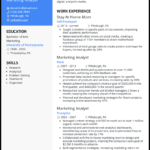
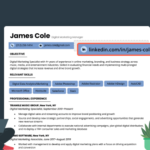

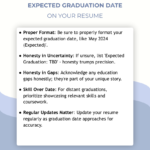

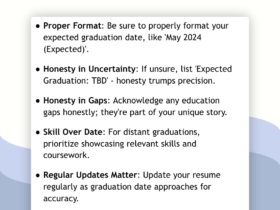
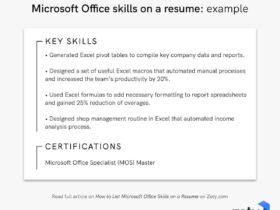
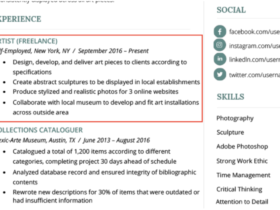
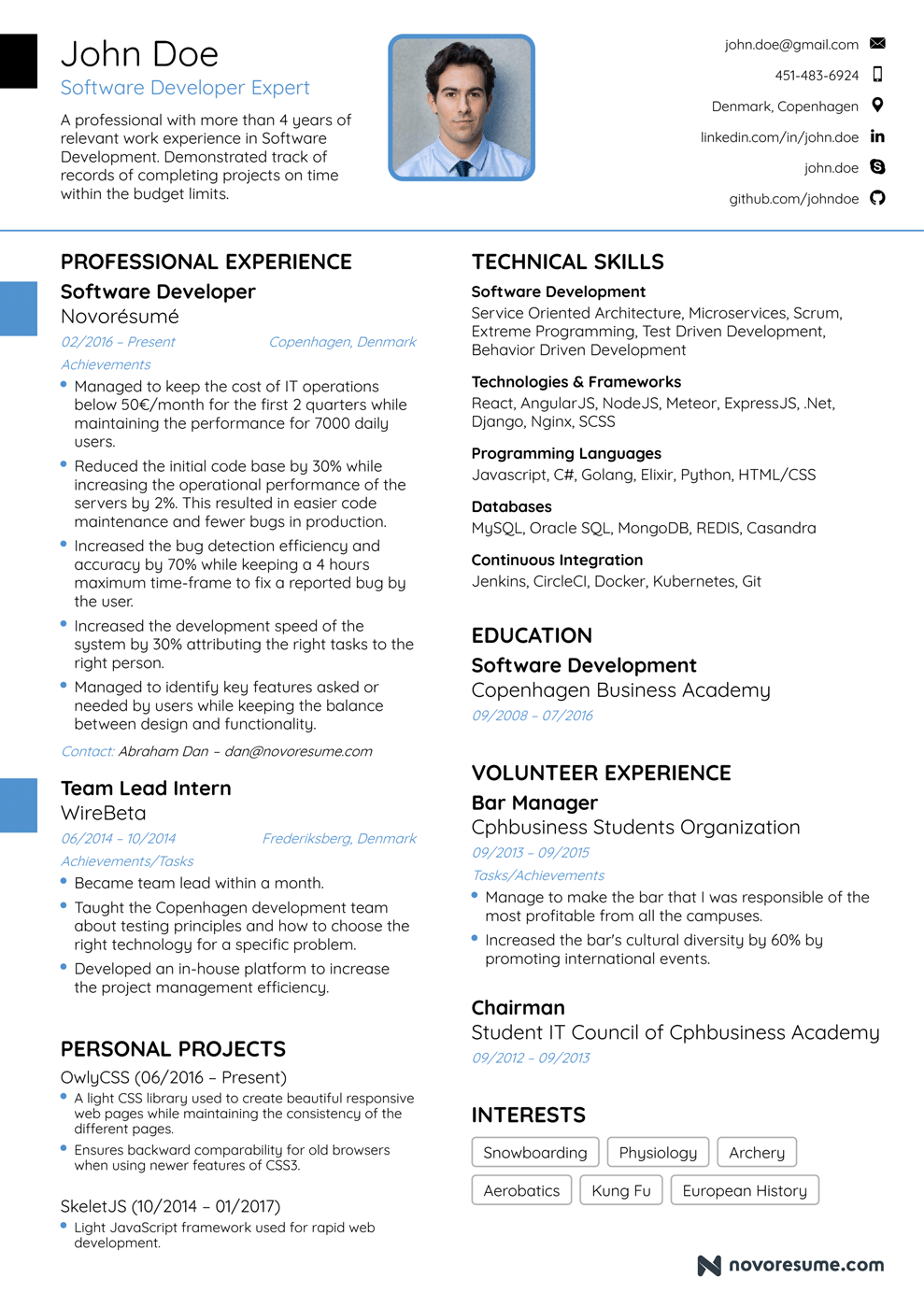
Leave a Reply